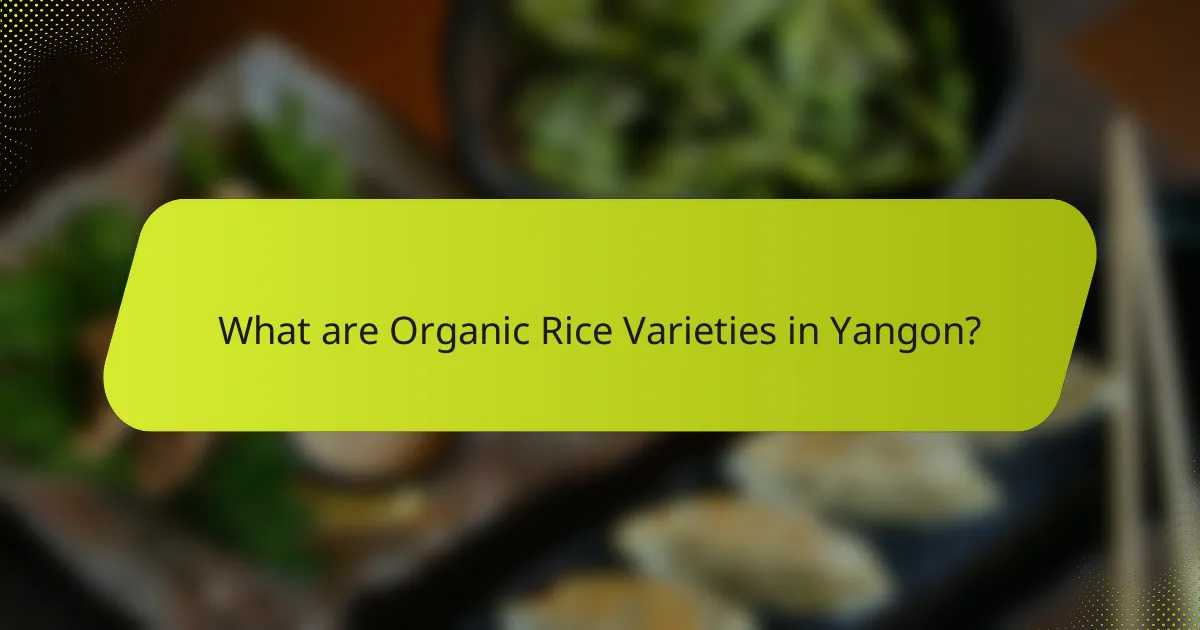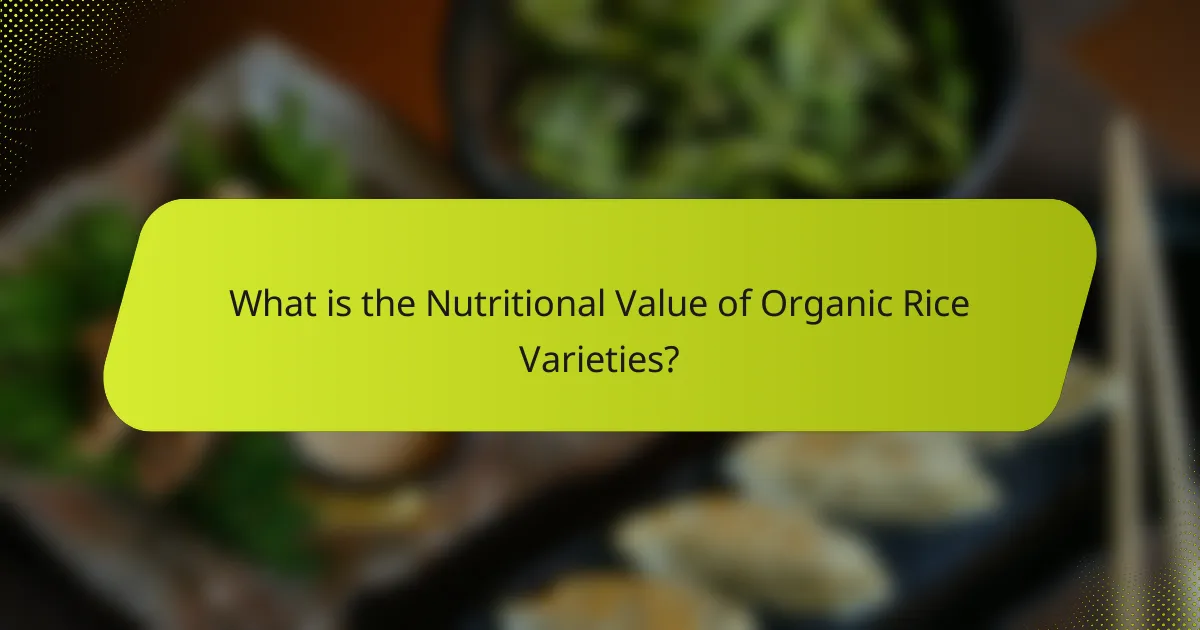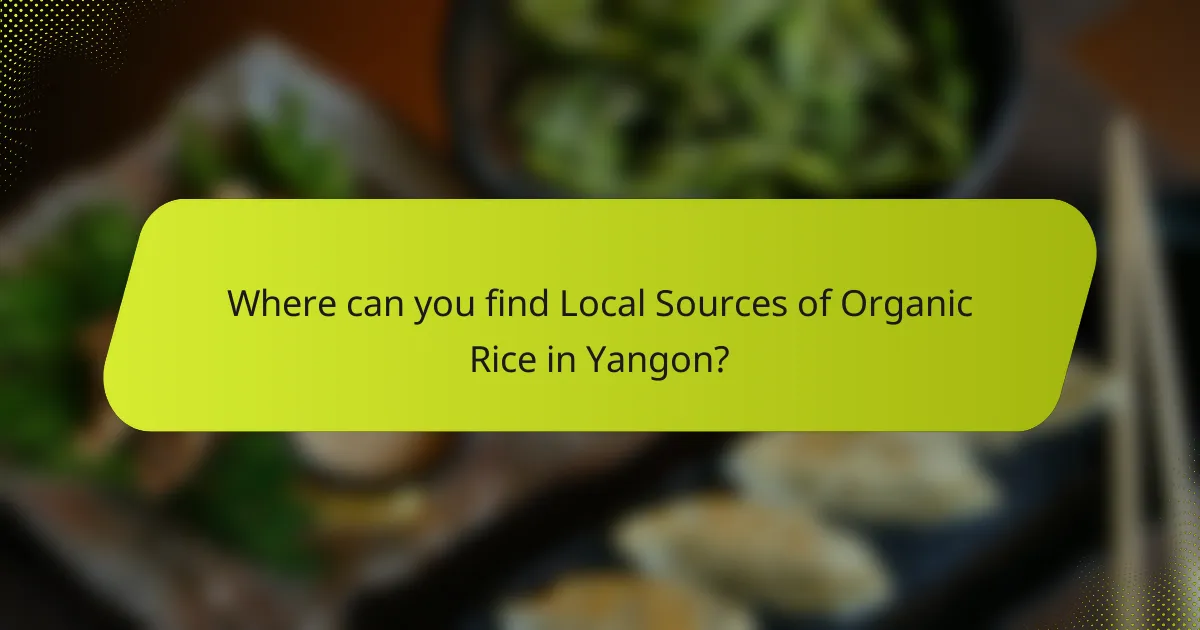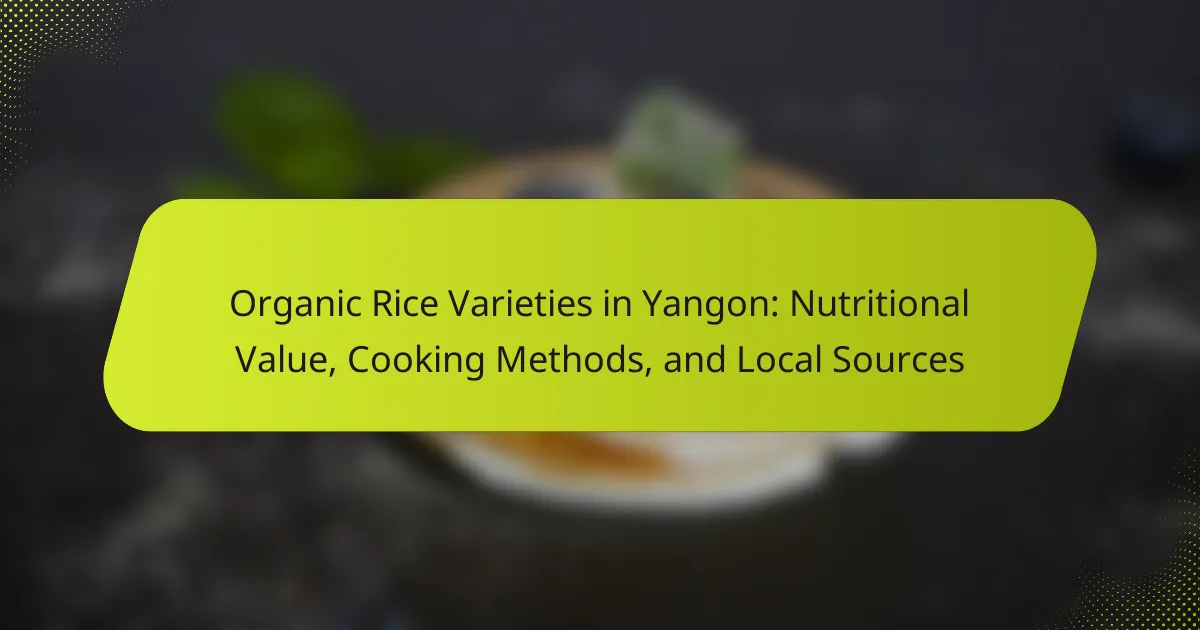Organic rice varieties in Yangon include Paw San, Khao Hlan, and Khao Nyaung, each with distinct characteristics and benefits. Paw San is known for its fragrant aroma and sticky texture, while Khao Hlan is valued for its high yield and nutritional content. Khao Nyaung is recognized for its unique taste, often featured in traditional dishes. These varieties are cultivated using organic farming practices that enhance quality and sustainability, supporting local economies and promoting environmental health. The article also covers the nutritional profile of these rice varieties, cooking methods such as boiling, steaming, and pilaf, and local sources where consumers can purchase organic rice in Yangon.

What are Organic Rice Varieties in Yangon?
Organic rice varieties in Yangon include varieties such as Paw San, Khao Hlan, and Khao Nyaung. Paw San is known for its fragrant aroma and sticky texture. Khao Hlan is appreciated for its high yield and nutritional value. Khao Nyaung is characterized by its unique taste and is often used in traditional dishes. These varieties are cultivated using organic farming practices, which enhance their quality and sustainability. Organic rice farming in Yangon supports local economies and promotes environmental health. The region’s climate and soil conditions contribute to the distinct characteristics of these rice varieties.
Why are Organic Rice Varieties important in Yangon?
Organic rice varieties are important in Yangon due to their health benefits and environmental sustainability. These rice types are free from synthetic pesticides and fertilizers. They promote better health by reducing chemical exposure for consumers. Furthermore, organic farming practices enhance soil fertility and biodiversity. In Yangon, the demand for organic products is rising among health-conscious consumers. This trend supports local farmers in adopting sustainable agricultural practices. Organic rice cultivation can also improve local economies by providing premium pricing for farmers. Overall, organic rice varieties contribute to a healthier population and a sustainable environment in Yangon.
What distinguishes Organic Rice from conventional rice?
Organic rice is distinguished from conventional rice primarily by its cultivation methods. Organic rice is grown without synthetic fertilizers, pesticides, or genetically modified organisms. This method promotes biodiversity and soil health. In contrast, conventional rice often relies on chemical inputs to enhance growth and yield. Studies show that organic farming can lead to higher levels of certain nutrients. For example, organic rice may contain more antioxidants and vitamins. Additionally, organic rice production practices aim to reduce environmental impact. This includes crop rotation and natural pest control methods. Thus, the key differences lie in cultivation practices, nutritional content, and environmental sustainability.
How do local farming practices influence Organic Rice in Yangon?
Local farming practices significantly influence organic rice production in Yangon. Traditional methods, such as crop rotation and intercropping, enhance soil fertility. These practices reduce the need for synthetic fertilizers, thereby maintaining organic standards. Additionally, local farmers often use indigenous seed varieties. These seeds are adapted to local conditions and contribute to biodiversity. Water management techniques, like rainwater harvesting, also play a crucial role. They ensure sustainable irrigation and reduce dependency on external water sources. Furthermore, community knowledge and practices are shared among farmers. This leads to improved techniques and better yields. Collectively, these factors contribute to the quality and sustainability of organic rice in Yangon.
What are the different types of Organic Rice Varieties available in Yangon?
The different types of organic rice varieties available in Yangon include Myanmar Jasmine Rice, which is known for its aromatic flavor. Another variety is the Shwebo Rice, recognized for its high quality and taste. There is also the Pathein Rice, which is popular for its texture and cooking versatility. Additionally, the Khao Dawk Mali rice variety is appreciated for its fragrance and is often used in traditional dishes. These varieties are cultivated using organic farming methods, ensuring they are free from synthetic chemicals. Organic rice production in Yangon has been supported by local farmers and agricultural initiatives, promoting sustainable practices.
What are the key characteristics of each Organic Rice Variety?
The key characteristics of each organic rice variety include their grain type, flavor, texture, and cooking properties. For example, Jasmine rice has a fragrant aroma and a slightly sticky texture when cooked. Basmati rice is known for its long grains and nutty flavor. Brown rice retains its bran layer, offering higher fiber content and a chewier texture. Black rice, rich in antioxidants, has a deep color and a slightly sweet taste. Sticky rice is glutinous and often used in desserts. Each variety serves different culinary purposes and nutritional benefits.
How do the flavors and textures vary among these Organic Rice Varieties?
Organic rice varieties exhibit distinct flavors and textures. For example, Jasmine rice has a fragrant aroma and a soft, slightly sticky texture. In contrast, Basmati rice offers a nutty flavor with a fluffy, non-sticky texture. Short-grain rice tends to be more tender and sticky, making it ideal for sushi. Brown rice has a chewy texture and a nutty flavor due to its bran layer. These differences arise from the specific growing conditions and genetic traits of each variety. Research indicates that the cooking method also impacts the final flavor and texture. For instance, soaking rice before cooking can enhance its texture and reduce cooking time.

What is the Nutritional Value of Organic Rice Varieties?
Organic rice varieties typically contain essential nutrients such as carbohydrates, proteins, and dietary fiber. They also provide vitamins like B1, B3, and minerals such as magnesium and phosphorus. For instance, one cup of cooked organic brown rice offers about 218 calories, 5 grams of protein, and 3.5 grams of fiber. Additionally, organic rice has lower levels of harmful substances compared to conventional varieties. Studies indicate that organic farming practices enhance the nutritional profile by reducing pesticide residues. This information highlights the health benefits associated with consuming organic rice varieties.
How does the nutritional profile of Organic Rice compare to conventional rice?
Organic rice generally has a higher nutritional profile compared to conventional rice. Organic rice contains more antioxidants, vitamins, and minerals. Studies indicate that organic rice can have higher levels of certain micronutrients, such as iron and zinc. Additionally, organic rice is grown without synthetic pesticides or fertilizers. This may lead to a cleaner product with fewer harmful residues. Research shows that organic farming practices can enhance soil health, which may contribute to better nutrient uptake by plants. Furthermore, organic rice often has a lower glycemic index, making it a better choice for blood sugar management.
What essential nutrients are found in Organic Rice Varieties?
Organic rice varieties contain essential nutrients such as carbohydrates, proteins, and dietary fiber. They are also rich in vitamins, including B vitamins like thiamine and niacin. Additionally, organic rice provides minerals such as iron, magnesium, and phosphorus. These nutrients contribute to energy production and overall health. Studies show that organic rice can have higher antioxidant levels compared to conventional rice. This enhances its nutritional profile. The presence of these nutrients supports various bodily functions and promotes well-being.
How do cooking methods affect the nutritional value of Organic Rice?
Cooking methods significantly influence the nutritional value of organic rice. Different techniques can alter the levels of vitamins, minerals, and other nutrients. For instance, boiling rice can lead to nutrient loss, particularly B vitamins and minerals, as they may leach into the cooking water. Steaming, on the other hand, tends to preserve more nutrients compared to boiling.
Additionally, frying rice can increase its calorie content due to added fats, while also affecting its glycemic index. Cooking times and temperatures can also impact the digestibility of the rice. Overcooking can break down nutrients, while proper cooking can enhance nutrient absorption.
Research indicates that cooking methods like soaking before cooking can reduce cooking time and preserve nutrients. Thus, the choice of cooking method is crucial for maximizing the nutritional benefits of organic rice.
What health benefits are associated with consuming Organic Rice?
Organic rice provides several health benefits. It is often higher in nutrients compared to conventional rice. Organic rice contains more antioxidants, which help combat oxidative stress. It is also free from synthetic pesticides and fertilizers. This reduces the risk of chemical exposure. Additionally, organic rice is typically less processed, retaining more of its natural fiber. The fiber content aids in digestion and promotes gut health. Studies indicate that consuming whole grains like organic rice can lower the risk of heart disease. Overall, organic rice supports a healthier lifestyle due to its nutritional profile and absence of harmful chemicals.
How does Organic Rice contribute to a balanced diet?
Organic rice contributes to a balanced diet by providing essential nutrients and energy. It is a good source of carbohydrates, which are vital for energy production. Organic rice also contains fiber, aiding in digestion and promoting gut health. Additionally, it is low in fat and free from harmful chemicals, making it a healthier choice. Studies show that organic rice retains higher levels of antioxidants compared to conventional rice. These antioxidants help combat oxidative stress in the body. Furthermore, organic rice varieties often have a higher mineral content, including magnesium and phosphorus, which are important for bone health. Overall, incorporating organic rice into meals supports nutritional balance and overall well-being.
What role does Organic Rice play in managing specific health conditions?
Organic rice can play a beneficial role in managing specific health conditions. It is known for being gluten-free, making it suitable for individuals with celiac disease or gluten intolerance. Organic rice also has a low glycemic index, which helps regulate blood sugar levels, beneficial for diabetes management. The fiber content in organic rice aids in digestion and can help prevent constipation. Additionally, it is rich in essential nutrients like magnesium and B vitamins, supporting overall metabolic health. Studies show that consuming whole grains, including organic rice, can reduce the risk of heart disease. These characteristics make organic rice a valuable dietary option for various health conditions.

What are the Cooking Methods for Organic Rice Varieties?
Cooking methods for organic rice varieties include boiling, steaming, and pilaf. Boiling involves cooking rice in water until tender. This method is straightforward and ensures even cooking. Steaming retains more nutrients and flavor. It requires a steamer basket or a rice cooker. Pilaf involves sautéing rice in oil before adding liquid. This method enhances the rice’s flavor and texture. Each method varies in cooking time and water ratio. For example, boiling typically requires a 2:1 water-to-rice ratio. Steaming may need less water. Pilaf usually requires more liquid than boiling. These methods are widely used for various organic rice types.
What are the common cooking methods used for Organic Rice in Yangon?
The common cooking methods used for organic rice in Yangon include boiling, steaming, and frying. Boiling is the most prevalent method, often resulting in fluffy rice. Steaming is also popular, especially for dishes like rice cakes. Frying, often combined with vegetables or meat, creates flavorful rice dishes. These methods are widely practiced in local households and restaurants. Traditional recipes often dictate the choice of cooking method. For instance, fried rice is a staple in many meals. Each method enhances the rice’s texture and taste, making it versatile in local cuisine.
How do different cooking methods affect the taste and texture of Organic Rice?
Different cooking methods significantly influence the taste and texture of organic rice. Boiling typically results in a softer texture, allowing grains to absorb more water. This method enhances the rice’s natural flavors. Steaming preserves more nutrients and creates a firmer texture, resulting in a chewier bite. Frying, such as in pilaf, adds a nutty flavor and a crispy texture due to the oil. Baking can create a crusty exterior while keeping the inside moist, altering both taste and texture. Each method offers distinct sensory experiences, showcasing the versatility of organic rice in culinary applications.
What tips can enhance the cooking process of Organic Rice?
Rinsing organic rice before cooking improves its texture and removes excess starch. Use a fine mesh strainer and rinse under cold water until the water runs clear. This step prevents the rice from becoming gummy during cooking.
Soaking organic rice for 30 minutes enhances its cooking efficiency. Soaking allows grains to absorb water and cook evenly. This method reduces cooking time by about 10-15 minutes.
Using the right water-to-rice ratio is crucial. A common ratio is 2 cups of water for every 1 cup of rice. Adjustments may be needed based on the specific variety of organic rice.
Cooking organic rice on low heat prevents burning and ensures thorough cooking. Once boiling, reduce the heat to a simmer and cover the pot. This technique retains moisture and flavor.
Letting the rice rest after cooking is essential. Allow it to sit covered for 10 minutes before fluffing. This resting period helps grains firm up and improves overall texture.
What are the best practices for preparing Organic Rice?
Rinse organic rice thoroughly before cooking to remove excess starch. This helps prevent the rice from becoming gummy. Use a ratio of 1 cup of rice to 2 cups of water for cooking. Bring the water to a boil before adding the rice. Reduce the heat to low and cover the pot. Simmer for about 18-20 minutes until the water is absorbed. Let the rice rest for 5-10 minutes after cooking. Fluff the rice with a fork before serving. These practices enhance the texture and flavor of organic rice.
How can soaking and rinsing improve the quality of cooked Organic Rice?
Soaking and rinsing improve the quality of cooked organic rice by removing excess starch and impurities. This process leads to less stickiness in the final dish. When rice is soaked, it absorbs water, which helps it cook more evenly. Rinsing prior to cooking further cleans the grains, ensuring a better texture. Studies show that rinsing can reduce cooking time by up to 20%. Soaked rice also tends to retain more nutrients during cooking. Overall, these methods enhance the flavor and appearance of organic rice dishes.
What are common mistakes to avoid when cooking Organic Rice?
Common mistakes to avoid when cooking organic rice include not rinsing the rice before cooking. Rinsing removes excess starch, preventing clumping. Another mistake is using too much water. Organic rice typically requires a specific water-to-rice ratio, often 1.5 to 2 cups of water per cup of rice. Failing to let the rice rest after cooking is also common. Resting allows the moisture to distribute evenly. Additionally, stirring the rice while it’s cooking can lead to a gummy texture. Lastly, not using a tight-fitting lid can cause steam loss, affecting the cooking process.

Where can you find Local Sources of Organic Rice in Yangon?
Local sources of organic rice in Yangon can be found at various markets and farms. The Yangon Farmers’ Market offers a selection of organic rice from local producers. Additionally, the Thiri Mingalar Market is known for organic grains, including rice. Local farms in the outskirts of Yangon also sell organic rice directly to consumers. Some farms participate in community-supported agriculture programs. These programs allow consumers to purchase organic rice directly from the producers. The availability of organic rice may vary by season. It is advisable to visit these locations regularly for the freshest options.
What are the best local markets for purchasing Organic Rice in Yangon?
The best local markets for purchasing organic rice in Yangon include the Bogyoke Aung San Market and the Dala Market. Bogyoke Aung San Market is known for its variety of organic products. It features multiple vendors specializing in organic rice. Dala Market offers direct access to local farmers. This market provides fresh, locally sourced organic rice options. Both markets are popular among residents seeking high-quality organic rice.
How can you identify high-quality Organic Rice at local sources?
To identify high-quality organic rice at local sources, look for specific certifications. High-quality organic rice should have certification from recognized bodies such as USDA or local organic certifiers. Additionally, check for clear labeling that indicates the rice is organic. The appearance of the rice is also important; it should be clean, with no broken grains or foreign materials.
Smell the rice; high-quality organic rice has a fresh, earthy aroma. Taste samples if possible; it should have a pleasant flavor. Ask local vendors about their sourcing practices. Reliable vendors often provide information about where and how the rice was grown. Finally, consider purchasing from reputable local farmers’ markets or cooperatives known for quality products.
What are the benefits of buying Organic Rice from local sources?
Buying organic rice from local sources supports sustainable agriculture. Local farmers often use eco-friendly practices. This reduces chemical runoff and promotes biodiversity. Freshness is another key benefit. Local rice is typically harvested and sold quickly. This ensures higher nutritional content. Additionally, purchasing locally boosts the local economy. It helps create jobs and supports community development. Furthermore, local sourcing reduces transportation emissions. This contributes to a lower carbon footprint. Overall, buying organic rice locally benefits health, the environment, and the community.
How does supporting local farmers contribute to the community?
Supporting local farmers strengthens community ties and boosts the local economy. When consumers buy from local farmers, they keep money within the community. This practice increases local employment opportunities. Farmers often hire local workers, which reduces unemployment rates. Additionally, supporting local agriculture promotes food security. Fresh produce is more accessible, leading to healthier diets. Local farmers typically use sustainable practices, benefiting the environment. A study by the American Farmland Trust shows that local food systems can generate up to three times more economic activity than conventional food systems. Therefore, supporting local farmers is crucial for community development and sustainability.
What are some practical tips for selecting and storing Organic Rice?
Select organic rice by checking for certification labels. Look for grains that are whole, unbroken, and free from discoloration. Ensure there are no signs of pests or mold. Store organic rice in an airtight container to prevent moisture and pests. Keep it in a cool, dark place to maintain freshness. For long-term storage, consider refrigeration or freezing. Properly stored organic rice can last for years without losing quality.
Organic rice varieties in Yangon, such as Paw San, Khao Hlan, and Khao Nyaung, are cultivated using sustainable practices that enhance their quality and nutritional value. This article explores the importance of organic rice, its distinctive characteristics compared to conventional rice, and the influence of local farming practices on production. It also discusses the nutritional benefits of organic rice, various cooking methods, and local sources for purchasing high-quality rice. By supporting local farmers and understanding the attributes of organic rice, consumers can contribute to healthier diets and sustainable agriculture in Yangon.
